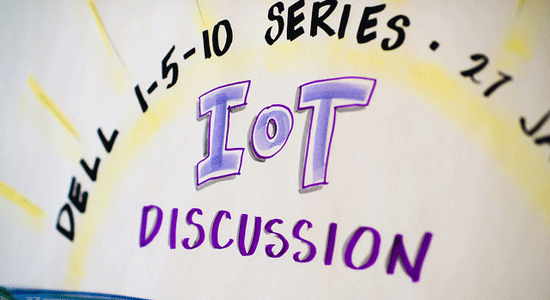The following is a guest post by Joseph di Paolantonio and Clarise Z Doval Santos who recently attended Dell's 1-5-10 Series discussion on the Internet of Things (IoT).
************
The Internet of Things, and Data Management and Analytics are the basis of our research. We were very excited when given the opportunity to speak with Shawn Rogers and Kevin Terwilliger of Dell about the IoT predictions by Jason Shepherd and Advanced Analytics predictions by Shawn.
Let’s take a closer look. Dell predicts that…
Enterprise will become the largest market for IoT adoption with Analytics most significantly affecting vertical markets, especially manufacturing – We agree, but the money will be in bringing consumer data into industrial context.
- Fitness bands are evolving into health monitors; these data will enter electronic medical records.
- Companies compile environmental, duty cycle and component failure data for OEMs to make better reliability predictions and warranties.
IoT data and sensor analytics will help manufacturing improve process controls and fine-tune supply chains; more importantly, predictive maintenance data will allow manufacturing of customized products, matching consumers’ environments and duty-cycles.
Standardization and interoperability of IoT technology will become a focal point – One can hope. Standardization may be a focus in 2016 but consolidation may take decades. Interoperability is of primary importance to deriving value from IoT data and sensor analytics. One possible solution is the creation and management of open and published application programming interfaces (APIs) including metadata. This may be the year when the Blockchain emerges as an excellent interoperability mechanism for the IoT.
Massive amounts of Big Data will drive the need for edge analytics and the emergence of stream analytics with analytics at the edge becoming the new normal spurred by the IoT – 2016 will see growing awareness that streaming analytics is vital. Pushing analytics to the source is a newer concept. One fault of consumer IoT apps is their reliance on the Cloud for processing, e.g. making fitness bands useless when one’s smartphone isn’t connected. The use of IoT data in industrial/governmental settings will require local, streaming sensor analytics, both for real-time autonomous decisions and real-time decision support. There are layers between the sensor-actuator feedback loop, and the core IT and OT systems; the goal is to store, score, analyze and update at appropriate points along this continuum.
Security threats will rise, creating a larger need to identify and implement stronger security practices – The security threats are already there, and the many publicized breaches have shown us that the old ways of firewalls and heuristics simply don’t work. We look at how security, convenience, privacy and transparency will work together to create two-way accountability among things and data sets to build trust among machines.
Companies will witness the emergence of a new role: the Chief IoT Officer – Cool: “where do I apply?”…check LinkedIn…nothing…shucks. Such job posts should require the need to understand the IoT as a complex system including hardware, software and humans at least to the extent of bringing together multi-disciplinary teams that will worry about interfaces and context. The underlying sentiment is that organizations of all types must adopt IoT. We put it as "support or participate in sensor analytics ecosystems by 2020 or wither away by 2025"
The role of the Citizen Data Scientist will continue to expand and evolve – This is about the expanding need for advanced analytics among those who are not formally charged with creating any analytics. This is not the business analyst adopting self-service tools beyond a spreadsheet. This is about productionalizing the inferences and predictions from advanced analytics to anyone who needs these insights to improve the performance of their decisions.
All innovation will trace back to analytics – Studies have shown that human-machine teams outperform single human or machine experts; think chess grand master vs. chess expert system vs. a team of chess players and narrow artificial intelligence (nAI). Humans bring innovation and risk acceptance to the party. Machines bring precision and speed to interweaving complex streams of data. The future of work will be such human-machine teams.
Will all these predictions come to pass in 2016? As William Gibson says, “The future is already here, just not very evenly distributed.” For some organizations, these things are happening right now.
************
 Clarise Z. Doval Santos, PMP: Independent Consultant. Clarise has experience as a strategic consultant, program manager, technical lead and practitioner in all areas of data management and analytics. She has headed data warehousing, BI and Analytics practices in both Fortune 100 organizations and boutique consultancies. She is passionate about using data to help those with disabilities and severe medical conditions. Her current focus is Health Care, Mobile, AgileBI and Open Source. She is the co-creator of the 8D BI Implementation Method, which was declared Agile in 2002 by a Practitioner, and is a signatory of the Agile Manifesto. Clarise blogs for The TeleInterActive Press. @CZDS
Clarise Z. Doval Santos, PMP: Independent Consultant. Clarise has experience as a strategic consultant, program manager, technical lead and practitioner in all areas of data management and analytics. She has headed data warehousing, BI and Analytics practices in both Fortune 100 organizations and boutique consultancies. She is passionate about using data to help those with disabilities and severe medical conditions. Her current focus is Health Care, Mobile, AgileBI and Open Source. She is the co-creator of the 8D BI Implementation Method, which was declared Agile in 2002 by a Practitioner, and is a signatory of the Agile Manifesto. Clarise blogs for The TeleInterActive Press. @CZDS.
 Joseph A. di Paolantonio has over 35 years of experience as a manager, executive, analyst and consultant. He is focusing on research and synthesis at the intersection of the Internet of Things with advances in Data Management & Analytics by blending careers as:
Joseph A. di Paolantonio has over 35 years of experience as a manager, executive, analyst and consultant. He is focusing on research and synthesis at the intersection of the Internet of Things with advances in Data Management & Analytics by blending careers as:
- a research scientist in renewable energy,
- a system engineer developing Bayesian risk models for
- aerospace systems, and
- a lead for Enterprise Data Warehousing, Agile Business
- Intelligence and Data Science projects for telecommunications,
- network OEM, healthcare, publishing, education and government
- sectors.
He is intrigued as to how these new solutions spaces will be made economically feasible by this intersection. Prior to his current role, he was VP & Principal Analyst at Constellation Research, CEO of InterActive Systems & Consulting, Inc, Executive Director of Professional Services for The Williams Cos, and General Manager of IT Services for Capital Technologies Integration, Inc, President & Founder of SyReCon, COO & Founder of Montara Magic, and various line, project and program manager positions at Oracle, Lockheed PARL, Martin Marietta, Thiokol and SES. He has created unique Predictive algorithms, such as BayLife and RAMsim, and is the co-creator of the 8D BI Implementation Method, which was declared Agile in 2002. Joseph blogs for The TeleInterActive Press and Tweets as @JAdP.
.
